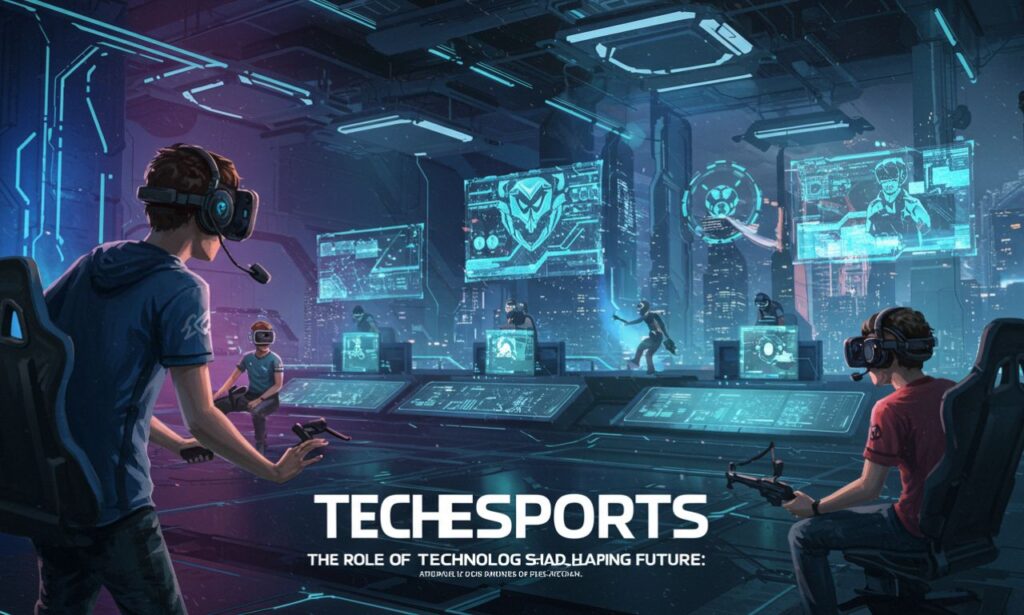The world of sports is evolving at an unprecedented pace, and at the heart of this transformation lies a fascinating concept known as tech etruesports. Blending cutting-edge technology with traditional athleticism, tech etruesports is reshaping how we engage with games, from the stadium to your living room. Imagine athletes wearing smart gear that enhances their performance or fans immersing themselves in live events through virtual reality. The future of sports isn’t just about competition; it’s also about innovation and connection. Join us as we explore the dynamic landscape where technology meets athletics and discover how these advancements are setting the stage for a thrilling new era in sports entertainment.
What is tech etruesports?
Tech etruesports refers to the fascinating intersection of technology and electronic sports. It encompasses everything from game development to streaming platforms that bring millions together.
At its core, tech etruesports is about innovation. Developers use cutting-edge technology to create immersive gaming experiences that challenge players on multiple levels.
This realm also includes hardware advancements, like high-performance gaming PCs and consoles designed for competitive play. Enhanced graphics and faster response times elevate gameplay significantly.
Moreover, tech etruesports relies heavily on data analytics. Teams analyze player performance in real-time, refining strategies based on solid metrics.
The rise of virtual reality (VR) adds another layer of complexity. Players can engage with their environments as never before, blurring the lines between reality and digital competition.
In essence, tech etruesports is reshaping how we understand sports itself through an ever-evolving technological lens.
The Impact of Technology on Traditional Sports
The integration of technology into traditional sports has revolutionized the way athletes train and compete. Wearable devices track performance metrics, providing insights that enhance training regimens. Athletes can analyze their movements in real-time, optimizing techniques for better results.
Video analysis software also plays a crucial role. Coaches dissect game footage to identify strengths and weaknesses, allowing teams to refine strategies effectively. This data-driven approach elevates the level of competition.
Moreover, fan engagement has transformed dramatically thanks to technology. Live streaming services bring games directly into homes worldwide, creating a global community around favorite teams and players. Enhanced viewing experiences with multiple camera angles keep fans on the edge of their seats.
From virtual reality simulations that prepare athletes mentally to advanced injury rehabilitation technologies, every aspect of traditional sports is evolving at lightning speed. These innovations are not just trends; they’re essential elements shaping modern athletics.
The Growing Popularity of E-Sports
E-sports have surged into the mainstream, captivating audiences worldwide. Once a niche hobby, competitive gaming now fills stadiums. Fans flock to major tournaments just like traditional sports events.
Each year, viewership numbers grow exponentially. Millions tune in for live-streamed matches on platforms like Twitch and YouTube. The thrill of watching skilled players clash draws an enthusiastic crowd.
The rise of e-sports also brings diverse demographics together. Gamers span all ages and backgrounds, uniting under a shared passion for competition and strategy.
Professional teams are forming rapidly, complete with sponsorship deals that rival those found in conventional sports leagues. Brands see value in engaging this vibrant community.
Gaming influencers play their part too; they boost visibility through social media channels and streaming games live to millions. This symbiotic relationship elevates both personalities and e-sports as a whole—making it an unstoppable force in entertainment today.
How Technology is Shaping the Future of Sports
Technology is revolutionizing the sports landscape in unprecedented ways. From advanced analytics to performance tracking, athletes and coaches now have access to data that enhances decision-making.
Wearable devices collect real-time metrics, allowing players to monitor their health and optimize training regimens. This data-driven approach leads not only to improved performance but also reduces injury risks.
Fan engagement has transformed as well. Interactive apps and streaming services provide immersive experiences, keeping audiences connected regardless of location. Augmented reality features enable fans to visualize plays from various angles right from their homes.
Moreover, innovations such as smart stadiums enhance the live event experience. With faster connectivity and personalized amenities, spectators enjoy a seamless visit while engaging with their favorite teams like never before.
As technology continues evolving at a rapid pace, its role in shaping competitive dynamics will only grow more significant across all levels of sport.
Virtual Reality and Augmented Reality in Sports
Virtual Reality (VR) and Augmented Reality (AR) are transforming the landscape of sports in unparalleled ways. Athletes can now train in simulated environments that closely mimic real-game scenarios, enhancing their skills without physical limitations.
Fans experience games like never before. With VR headsets, they can feel as if they’re sitting courtside or standing on the sidelines during pivotal moments. This immersion brings a new level of excitement to viewing experiences.
Coaches utilize AR for tactical analysis, overlaying game data onto live feeds for immediate feedback. This technology helps teams strategize effectively against opponents.
Moreover, VR is revolutionizing rehabilitation processes for injured athletes. Virtual simulations allow them to regain confidence and practice movements safely before returning to competition.
The ongoing evolution promises endless possibilities as tech etruesports continues its journey into mainstream acceptance.
The Role of Artificial Intelligence in E-Sports
Artificial Intelligence is transforming the landscape of e-sports in remarkable ways. It enables developers to create smarter game mechanics, offering players a more immersive experience.
AI algorithms analyze player behavior and adapt gaming environments accordingly. This personalization enhances engagement by tailoring challenges that suit individual skill levels.
In competitive play, AI assists in strategizing. Coaches use data-driven insights to refine tactics and improve team performance. These tools help identify strengths and weaknesses, giving teams a strategic edge.
Moreover, AI-driven matchmaking systems ensure balanced competition. They connect players of similar skill levels for fair gameplay experiences.
With continuous advancements, the future holds exciting possibilities for integrating AI into various aspects of e-sports, from training to live events. As technology evolves, so too will its impact on how we engage with digital sports competitions.
Predictions for the Future of Tech Etruesports
The future of tech etruesports is poised for remarkable transformations. As technology continues to evolve, we can expect more immersive experiences in both traditional and e-sports arenas.
Advancements in virtual reality will likely create environments where fans feel like they’re part of the action. Imagine stepping into your favorite game or sport as if you were a player on the field.
Artificial intelligence will refine gameplay strategies, allowing players to analyze opponents with unprecedented precision. This could lead to faster-paced games with higher stakes.
Wearable tech might also become standard, offering real-time performance data that enhances training routines and athlete recovery processes.
As connectivity improves, global tournaments may become commonplace—uniting players from diverse backgrounds on a single platform. Expect collaborations across industries too; think music festivals integrated with competitive gaming events.
These innovations promise an exhilarating ride ahead for tech etruesports enthusiasts everywhere.
Conclusion
The landscape of sports is evolving rapidly, driven by technological advancements that redefine how we play, watch, and engage with games. Tech etruesports stands at the forefront of this transformation. By merging traditional athletic competitions with cutting-edge technology, it paves the way for a future where barriers between physical and digital worlds blur.
As e-sports gain traction alongside conventional sports, their significance cannot be understated. The rise of virtual reality and augmented reality is creating immersive experiences that enhance viewer engagement while providing athletes with tools to improve their skills in innovative ways. Furthermore, artificial intelligence continues to revolutionize training methods and game strategies within both realms.
Looking ahead, tech etruesports promises exciting developments that will shape our entertainment landscape—creating new opportunities for athletes and fans alike. As technology progresses further into every facet of sports culture, the potential for growth remains boundless. Embracing these changes could lead us into an era defined by unprecedented connectivity and interaction among players and spectators worldwide.





